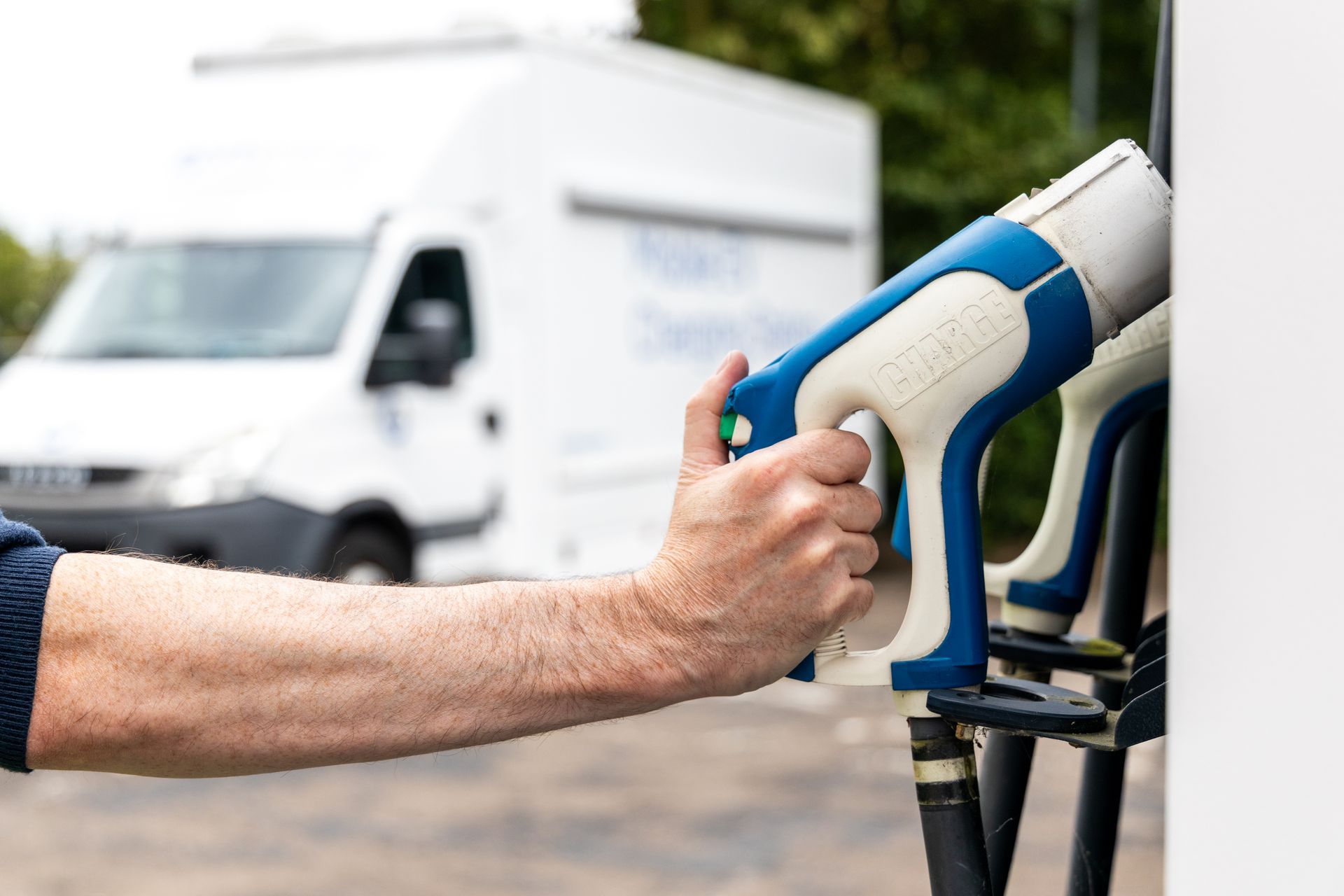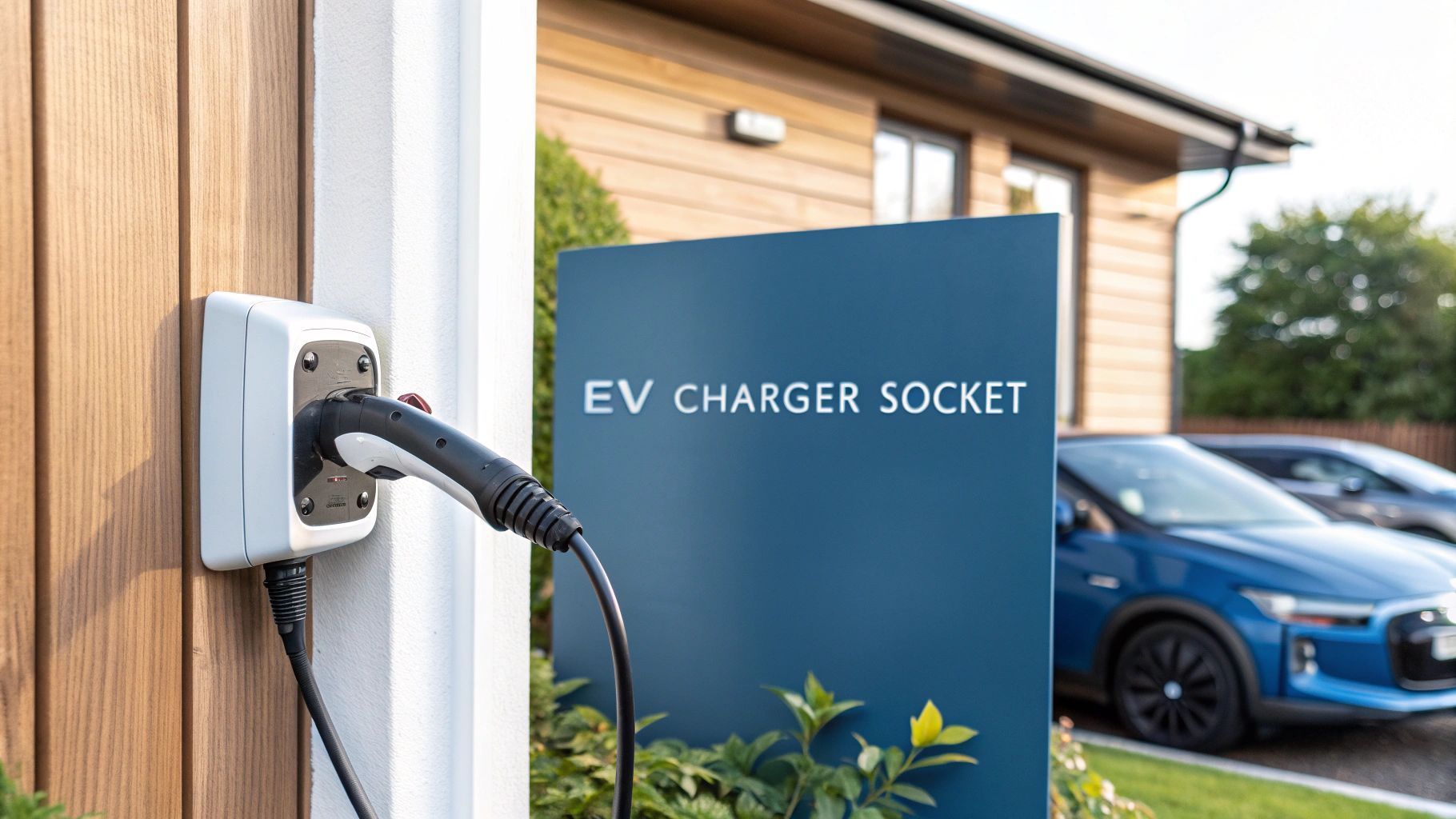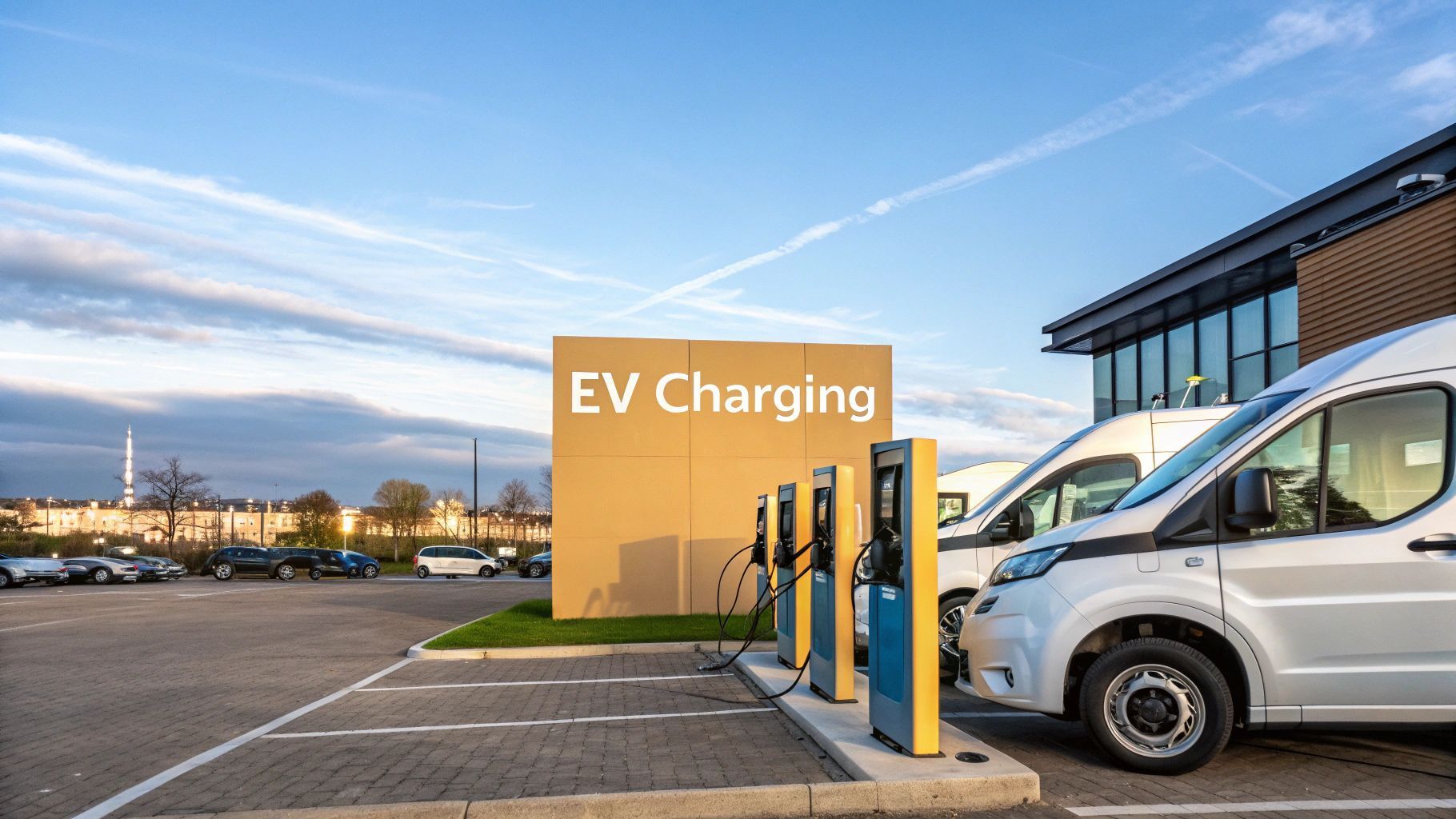Your Guide to a Plug In EV Charger Business in the UK
Think of a plug-in EV charger as the specialised fuel pump for the electric age. It’s the vital link that gets electricity from the grid into your car’s battery, whether it’s a fixed unit on your wall or a mobile service that comes to you. This piece of kit is the key to unlocking all the convenience and cost savings that come with driving electric.
The UK's Growing Demand for EV Charging Solutions
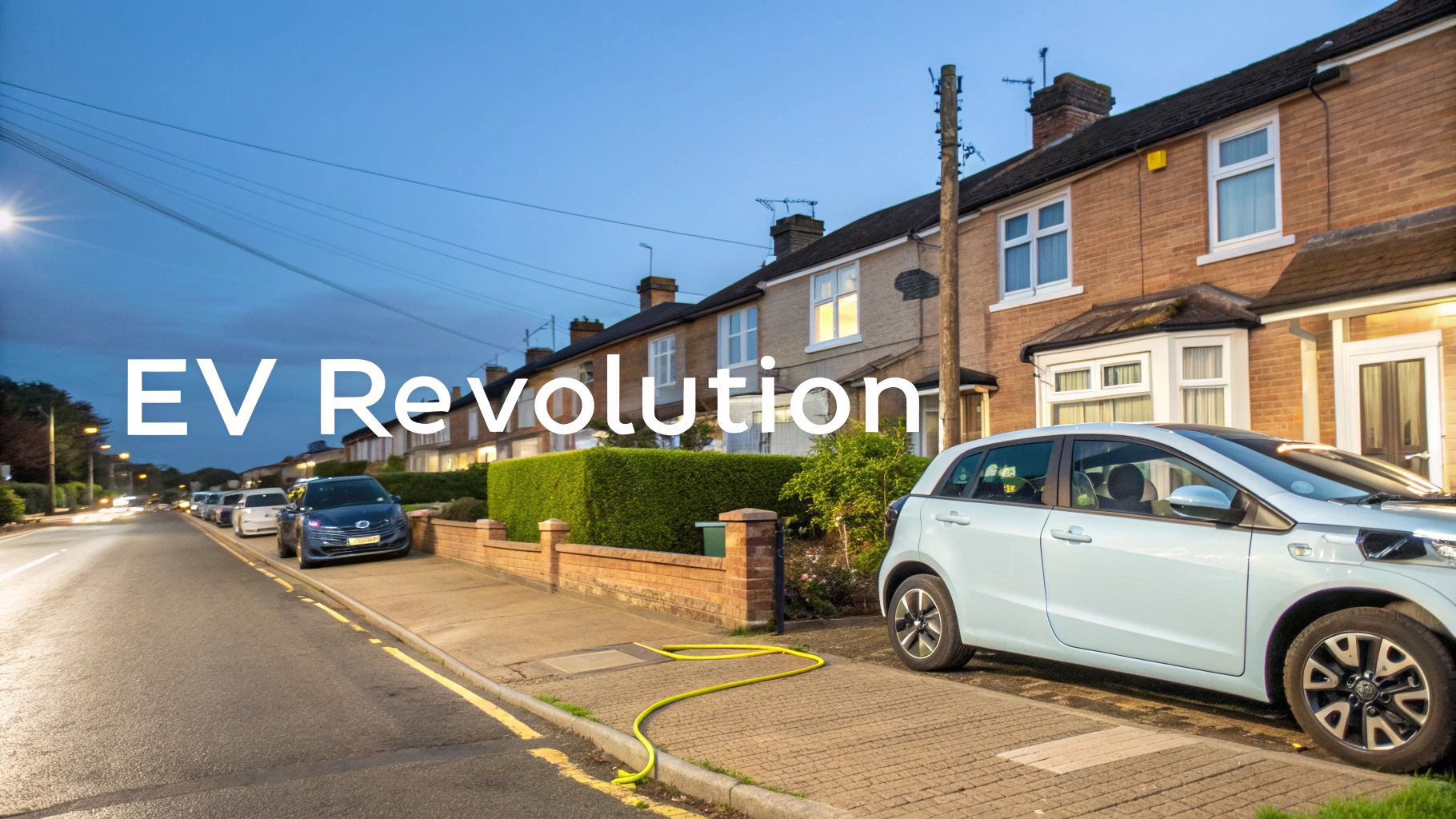
The UK is well and truly in the fast lane of an electric vehicle revolution. Because of this, understanding the tech behind a plug in EV charger has never been more important. With thousands of drivers making the switch from petrol and diesel every month, the demand for accessible, reliable charging has absolutely skyrocketed, creating a vibrant new market for smart energy solutions.
This guide is here to break down the essentials in simple terms. We’ll explore the key differences between the familiar fixed chargers you see at supermarkets and the flexible power of mobile EV charging. For drivers and budding entrepreneurs alike, getting a grip on these concepts is the first step to confidently navigating this new landscape.
A Market Ready for Innovation
The sheer growth in EV ownership is putting immense pressure on the public charging network we have today. While the network is expanding, frustrating gaps in coverage and all-too-common issues like occupied or out-of-service charge points are creating real headaches for drivers. This is where the opportunity really begins, especially for mobile charging.
A mobile EV charging service works a lot like roadside assistance but for electricity. It delivers on-demand power directly to a customer's location, solving immediate problems and offering a level of convenience that fixed infrastructure just can't match.
This model is a game-changer in a few key scenarios:
- Emergency Roadside Assistance: Helping drivers who’ve run flat and can't make it to a static charge point.
- Fleet Charging: Providing on-site top-ups for commercial fleets, like delivery vans or taxis, often overnight.
- "EV Deserts": Serving areas where public charging infrastructure is thin on the ground or non-existent.
The Scale of UK Charging Infrastructure
The UK's commitment to EVs is crystal clear when you look at the rapid growth of its public charging network. As of July 2025 , there were 82,002 publicly available charging devices across the country—a figure that jumped by a remarkable 27% in just one year. While this expansion is impressive, it also shines a light on the ongoing need for diverse solutions to support the ever-growing number of EVs on our roads.
This guide will show you how to turn this surging demand into a profitable business. We’ll set the stage for you to build a successful mobile charging service, covering everything from the technology you’ll need to the financial returns you can expect. For more context, you might also be interested in our guide to understanding the UK's public EV charging point networks in 2025.
Choosing Your Path: Fixed vs. Mobile Chargers
When you step into the world of EV charging, you're faced with a big decision right from the start: go with a fixed installation or embrace a mobile approach?
Fixed chargers are the ones we all know. They're bolted to the ground at supermarkets, motorway services and public car parks. They're the reliable workhorses of the UK's charging network but that permanence comes with some hefty downsides, namely high installation costs and being stuck in one place.
The alternative is a real game-changer that's quickly gathering momentum: mobile EV charging. Now, this isn't about those little power banks for a tiny top-up. Think of it as a professional-grade plug in ev charger built into a service vehicle, operating as an on-demand energy delivery service. It’s basically roadside assistance but for electricity—bringing the power right to your customer’s car.
The Power of On-Demand Service
The magic of a mobile model is its incredible flexibility. A fixed charger is no use to a driver who's run out of juice a mile down the road. A mobile charging service, on the other hand, can get to them anywhere, anytime, turning a potential disaster into a minor inconvenience. This unlocks a much wider, more dynamic market for operators.
Mobile units can reach customers in so-called 'EV deserts'—places with few or no fixed chargers. This could be new housing developments, rural communities or sprawling industrial parks where it just doesn’t make financial sense to install permanent infrastructure yet. By plugging these gaps, a mobile operator provides an essential service and builds a fiercely loyal customer base.
The real value of a mobile charging service is that you're selling convenience. You’re not just selling kilowatt-hours; you're selling a solution to an immediate problem, whether that's a dead battery on the M25 or the need for scheduled fleet charging without taking vehicles off the road.
Unlocking New Revenue Streams
It’s this convenience factor where the true earning potential of a mobile plug in ev charger business really shines. Unlike fixed points that are often stuck competing on a tight per-kWh price, a mobile service commands a premium. Your business model is built around a call-out fee plus the cost of the energy delivered, which creates a much healthier profit margin on every job.
Just think about the revenue streams that are completely out of reach for a fixed charger operator:
- Emergency Call-Outs: This is the bread and butter. You're the fourth emergency service for stranded EV drivers, giving them enough charge to reach their destination or a nearby rapid charger.
- Fleet Contracts: Businesses with electric vans and cars need them earning money, not sitting idle at a public charging point. You can offer scheduled overnight or depot-based charging, making sure their fleet is fully charged and ready for the next day's work.
- Event Services: Be the power behind the scenes at festivals, outdoor events or trade shows where permanent infrastructure simply doesn't exist.
- Dealership and Garage Support: Offer a lifeline service to car dealerships for new vehicle handovers or to garages that have an EV with a flat battery on their hands.
With a mobile unit, you're not chained to a single spot. You can follow the demand—targeting business parks during the week, residential streets in the evenings and popular tourist spots on weekends. This freedom to go where the money is, instead of waiting for it to come to you, gives mobile operators a massive commercial advantage.
Understanding Charger Speeds and Power Ratings
If you're running a mobile charging business, you need to speak the language of kilowatts and charging times. It’s simple, really: the speed of your plug in EV charger dictates how fast you can get a customer back on the road. And that, in turn, determines how many jobs you can handle in a single day. Getting this right is fundamental to offering a service people will pay for.
Think of it like filling a bucket with water. The power of a charger, measured in kilowatts ( kW ), is the flow rate from your tap. A slow trickle will take ages, just like a low-power charger will take hours to fill a car's battery. A powerful fire hose, however, gets the job done in moments. That’s the easiest way to picture the different charging speeds out there.
The infographic below breaks down the two main categories you'll come across: Fixed and Mobile.
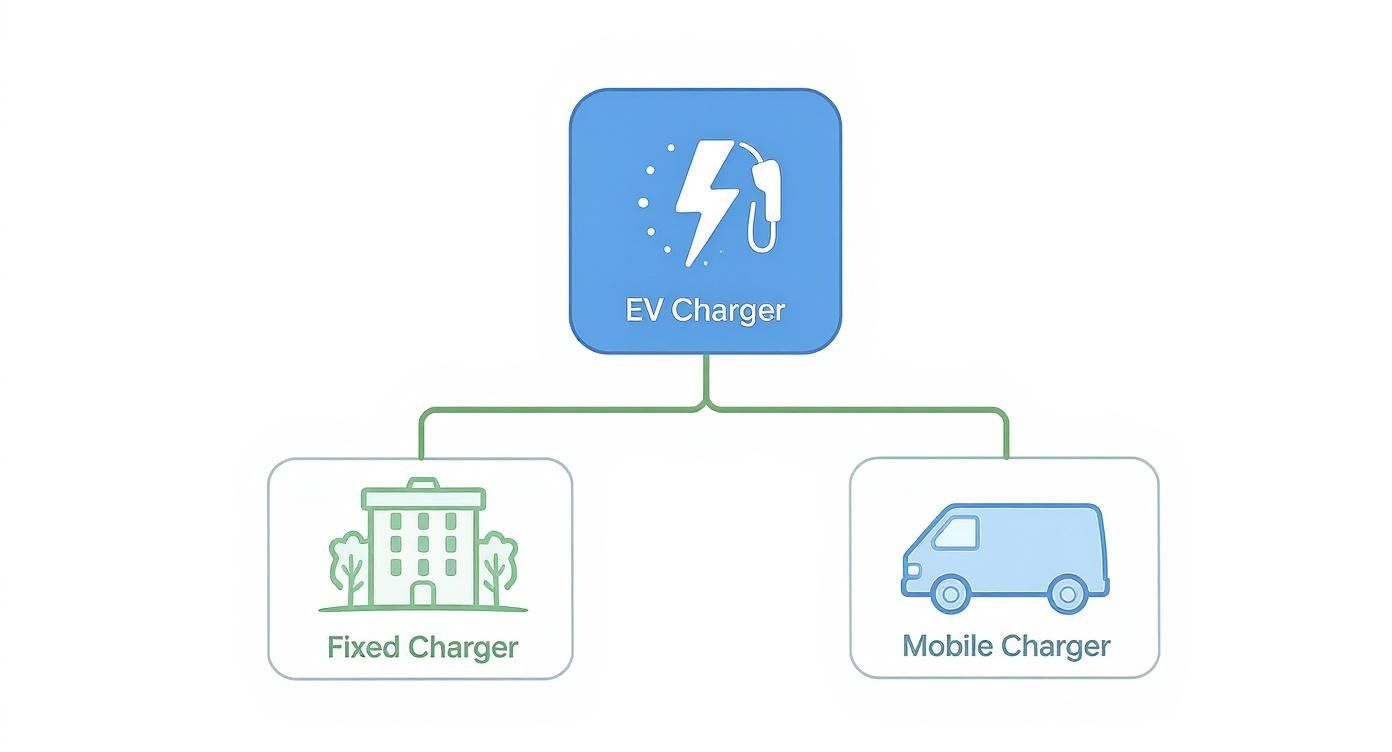
While fixed chargers are stuck in one place, your business will operate in the mobile category, bringing the power directly to your customers.
From Trickle to Turbo: A Breakdown of Charger Types
Here in the UK, the charging landscape is pretty varied, with different power levels designed for specific situations. As a mobile operator, you've got to know what your customers expect and what your gear can actually deliver. Your unit's power directly impacts your service speed—and your profitability.
Let's look at the different types of EV chargers available in the UK, broken down by their charging speed. The table below gives a clear comparison, showing how power output affects the time it takes to charge a typical 60kWh EV battery from 20% to 80% .
| Charger Type | Power Output (kW) | Estimated Charge Time (20-80%) |
|---|---|---|
| Slow (AC) | 3-7kW | 6-12 hours |
| Fast (AC) | 7-22kW | 2-4 hours |
| Rapid (DC) | 50kW+ | 30-40 minutes |
| Ultra-Rapid (DC) | 150kW+ | 10-20 minutes |
As you can see, the difference is huge. For a mobile service where time is money, the faster options are where the real potential lies.
Here’s a closer look at what those categories mean in the real world:
- Slow Chargers (3-7kW): Often called 'trickle' chargers, these are what you typically find in home installations. They're great for an overnight top-up, adding about 10-25 miles of range per hour but they’re far too slow for a viable mobile emergency service.
- Fast Chargers (7-22kW): A definite step up. You'll see these in public spots like supermarkets. A 22kW unit can add a decent chunk of range in an hour, making it more practical but it's still not ideal for rapid roadside assistance.
- Rapid & Ultra-Rapid Chargers (50kW+): Now we're talking. This is the top tier. Rapid chargers start at 50kW and can get a typical EV battery to 80% in about 30-40 minutes . Ultra-rapid units , starting at 150kW , can do the same job in as little as 15 minutes. For a mobile business, this is the gold standard.
The crucial takeaway for any mobile operator is that speed sells. A customer stranded at the roadside needs a meaningful amount of charge and they need it quickly. Your ability to deliver a rapid charge is what will set you apart and justify your call-out fee.
Matching Power to Profit
Choosing the right mobile plug in EV charger is one of the most important business decisions you'll make. A more powerful unit costs more upfront, no doubt. But it also lets you serve customers faster, which means you can fit more jobs into your day and boost your earning potential.
Think about your target market. If you’re focusing on emergency roadside assistance, a rapid DC charger isn't just nice to have—it's essential. Stranded motorists will happily pay a premium for a quick boost that gets them moving again. On the other hand, if you plan to service commercial fleets overnight, a less powerful (and more affordable) AC unit might be perfectly fine since the vehicles will be parked for hours anyway.
To get a better handle on the units involved, our guide explains how to calculate a kilowatt-hour and what it really means for charging.
Ultimately, your choice of charger speed comes down to balancing your initial investment against the quality of service you want to offer. The UK market is clearly shifting towards faster charging so putting your money into a rapid or ultra-rapid mobile unit today is a smart move that positions your business for future growth and higher profits.
How Much You Can Earn with a Mobile Charging Business
Jumping into the mobile charging market isn't just about providing a lifeline to stranded EV drivers—it's a serious business opportunity. But what does the bottom line actually look like? To get a real sense of your potential earnings, you need a clear picture of where the money comes from and what it costs to keep the wheels turning.
The entire business model is built on one thing: convenience. You aren't just selling electricity; you're selling a solution to an urgent problem and that service commands a premium. A mobile plug in EV charger service is a lot like a breakdown recovery service. Customers are paying for your speed, expertise and the sheer relief of getting back on the road when they need it most.
Breaking Down Your Revenue Streams
Your income won't come from a single source. The most successful mobile charging businesses create a blend of services to maximise their daily earnings. By combining different offerings, you can build a robust financial model that stays profitable around the clock.
The most common approach combines two key elements: a call-out fee and a per-kilowatt-hour (kWh) rate.
- The Call-Out Fee: Think of this as your base charge for getting your van to the customer. It covers your time, fuel and vehicle wear and tear. In the UK, this typically ranges from £40 to £80 , depending on the location and time of day. An emergency call-out at 2 AM on the M1 is naturally going to command a higher fee than a scheduled top-up in a town centre.
- The Per-kWh Rate: This is what you charge for the actual electricity. You’ll be adding a healthy markup to the standard rate to reflect the premium, mobile nature of your service. While public rapid chargers might bill between 70p and 85p per kWh , you could realistically charge £1.00 to £1.50 per kWh .
This dual-pricing structure ensures every job is profitable from the moment you turn the key.
Modelling Your Potential Daily Income
Let's bring these numbers to life and walk through a couple of realistic scenarios for a single day's work in the UK.
Scenario 1: The Emergency Specialist
Imagine you're focused purely on roadside assistance. On a typical day, you might handle five emergency calls.
-
Job 1 (Morning Rush): A driver has run out of juice near a busy business park. You deliver 15 kWh of charge.
- Call-Out Fee: £50
- Energy Charge (15 kWh @ £1.20/kWh): £18
- Total for Job 1: £68
-
Jobs 2 & 3 (Midday): Two similar call-outs, each needing a quick 10 kWh top-up.
- Call-Out Fees (2 x £50): £100
- Energy Charges (20 kWh @ £1.20/kWh): £24
- Total for Jobs 2 & 3: £124
-
Jobs 4 & 5 (Evening/Late Night): One stranded commuter and one late-night emergency, which carries a higher rate.
- Call-Out Fees (£50 + £75): £125
- Energy Charges (25 kWh @ £1.20/kWh): £30
- Total for Jobs 4 & 5: £155
In this scenario, your total daily revenue would be £347 . Working a five-day week, this single van operation could generate a weekly turnover of £1,735 , or over £85,000 annually from just a handful of jobs each day.
Scenario 2: The Fleet Services Provider
Now, let's picture a different model focused on business-to-business (B2B) contracts. You’ve secured a deal to service a local company's small fleet of ten electric delivery vans.
- Service: You visit their depot after hours, charging five vans one night and five the next.
- Charging: Each van needs a 40 kWh top-up to be ready for the morning shift.
- Contract Rate: You agree a fixed monthly fee or a discounted per-van rate. For example, a monthly retainer of £1,500 to guarantee their fleet is always ready to go.
This subscription model gives you a predictable and stable income stream. You can then fill your daylight hours with ad-hoc emergency calls, creating a highly profitable hybrid business. For anyone wanting to dig deeper into the numbers, you can learn more about how to profit with a portable charging station for electric cars in our detailed guide.
Factoring in Your Operational Costs
Of course, revenue is only half the story. To figure out your true profit margin, you have to account for your operational expenses. A clear-eyed view of these costs is crucial for long-term success.
Your main costs will include:
- The Vehicle: The initial purchase or lease of a suitable van (like a Ford Transit or Mercedes Sprinter).
- The Charging Unit: The mobile plug in EV charger itself is a significant capital investment.
- Insurance: Specialist business and public liability insurance for mobile electrical work is non-negotiable.
- Fuel/Energy: The cost to power your own service vehicle, whether it runs on diesel or electricity.
- Marketing: A budget for a website, local SEO and some advertising to get your first customers.
- Maintenance: Regular servicing for both your van and the charging equipment is a must.
While these costs can seem daunting, many can be managed through smart financing and efficient route planning. The high-profit margins on each job mean that a well-run mobile charging service can quickly cover its overheads and start generating substantial net profit, making it a very attractive venture for entrepreneurs in the EV space.
Getting Your Mobile EV Charging Service on the Road
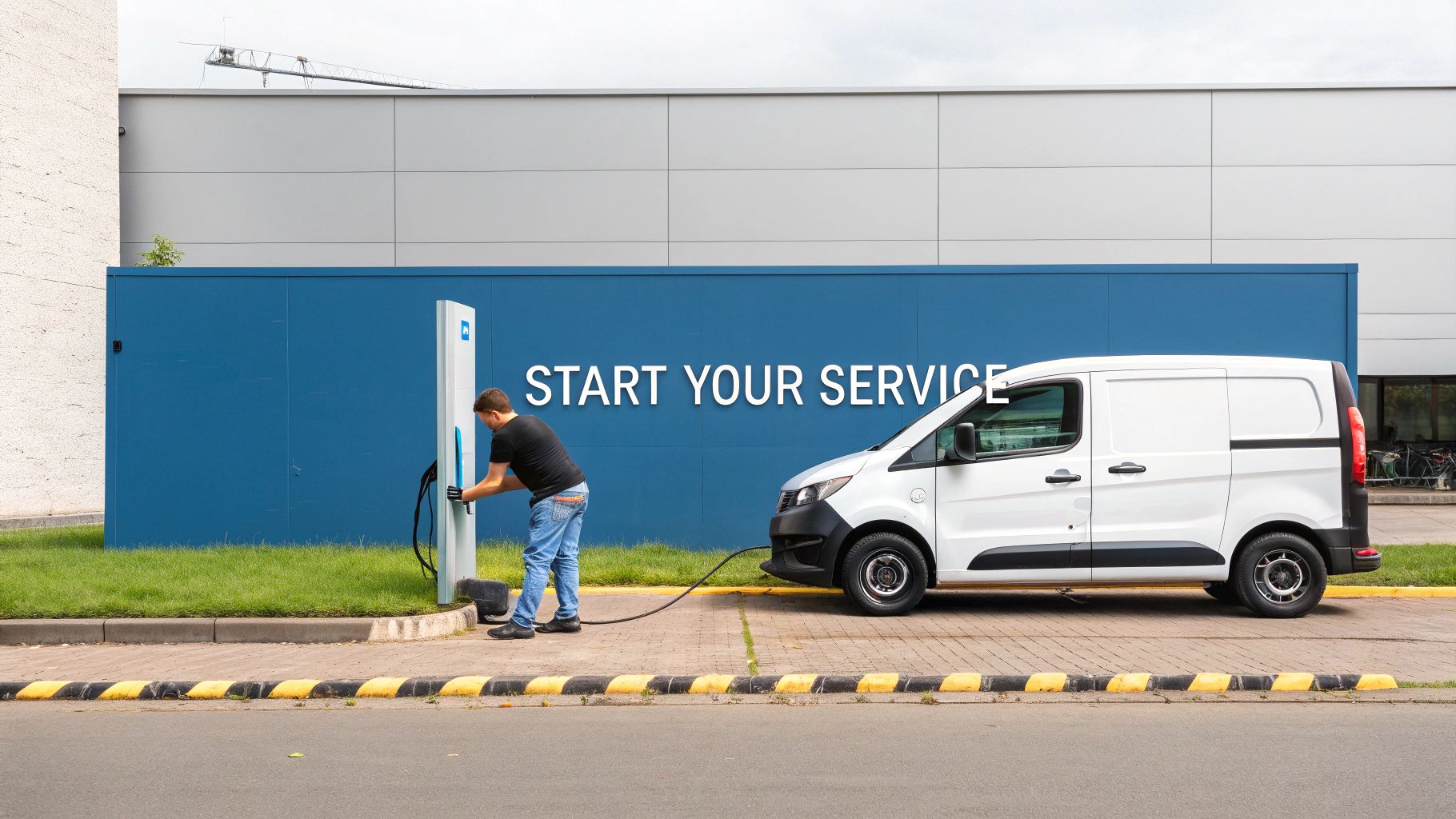
So, you’ve seen the market gap and the earning potential. Now it’s time to put your plan into action. Launching a mobile EV charging business is an exciting venture but your success will hinge on careful planning and execution. This is your step-by-step guide to getting your service up and running in the UK and turning a great idea into a profitable reality.
Your journey doesn't start with buying a van but with smart market research. The goal is to pinpoint underserved areas where your service will be a lifesaver. Look for ‘charging deserts’ – think new-build estates without home chargers, rural villages or business parks where the fixed infrastructure just hasn't caught up with EV adoption. A solid business plan is your roadmap, spelling out your mission, financial forecasts and operational strategy.
Building Your Mobile Charging Unit
Your two most important assets are the vehicle and the plug in ev charger itself. Choosing the right van is crucial; it needs enough payload capacity to safely carry the charging unit, which can be surprisingly heavy, plus any tools you’ll need. Models like the Ford Transit or Mercedes-Benz Sprinter are popular for a reason – they’re reliable and have the space you need.
Next, you need the heart of your operation: the mobile charger. Your choice here should tie directly back to your business plan.
- For emergency call-outs: A rapid DC unit is a must. It delivers a meaningful charge quickly, which justifies a premium price when someone is stranded.
- For fleet contracts: A less powerful but more affordable AC unit might be all you need for scheduled overnight charging at a depot.
Budget will always be a factor but splashing out on a more powerful unit from the get-go can deliver a faster return. You’ll be able to complete more jobs each day and serve a much wider range of customers.
Navigating UK Regulations and Insurance
Running a mobile electrical service in the UK means sticking to strict safety standards and legal requirements. This is one area you absolutely cannot afford to cut corners. You'll need specific business insurance that covers mobile electrical work and public liability. Insurers will almost certainly want to see proof of competence, which means you or your staff need the right electrical certifications or manufacturer-approved training.
Understanding the necessary safety certifications is non-negotiable. Your equipment must be professionally installed and regularly maintained to comply with UK electrical safety regulations, ensuring the protection of your customers, their vehicles and your business.
As you gear up for launch, figuring out how to maximise your mobile operation's flexibility is key to efficiency. Thinking about logistics, route planning and customer management from day one is vital for unlocking the benefits of mobile access and building a lean, profitable business.
Crafting Your Pricing and Marketing Strategy
Your pricing needs to be clear, competitive and profitable. Most operators combine a call-out fee with a per-kWh rate. Do some digging on what local breakdown services charge to get a benchmark for your call-out fee. Remember, you're not just selling electricity; you're selling an urgent, convenient solution.
The UK government has committed around £1.6 billion to speed up the rollout of EV charging infrastructure. This saw the public network grow by a massive 25% between January and September 2023 alone. While that growth is huge, many drivers find public charging fees steep. This gives you an opening to compete on convenience and reliability, especially when public chargers are all occupied or, worse, out of order.
With your prices sorted, the final step is marketing. Focus your energy on high-value customers who will need your service again and again.
- Corporate Fleets: Get in touch with local businesses running electric vans or company cars.
- Breakdown Services: Partner with local recovery firms and become their go-to EV assistance provider.
- Residential Communities: Target new housing estates and blocks of flats where charging options are limited.
By focusing on these practical steps, you can launch a mobile plug in ev charger service that doesn't just meet a growing demand but also builds a sustainable and profitable business from the ground up.
Your Plug-In EV Charger Questions Answered
As we get to the end of this guide, it's only natural to have a few questions rattling around. Stepping into a new business venture or just getting your head around a new bit of kit always brings up the practical stuff. This final section tackles some of the most common questions we hear from aspiring mobile charging operators and everyday EV drivers across the UK.
We’ve pulled together the most frequent queries to give you clear, straightforward answers. The goal is to give you the confidence that comes from knowing the details, clearing up the practical concerns that can make all the difference as you move forward.
Do I Need to Be a Qualified Electrician to Run a Mobile EV Charging Service?
This is a big one and the answer needs a bit of thought. While you might not legally need to be a time-served electrician just to operate the pre-installed charging equipment, it's something we strongly advise. You're dealing with high-voltage systems and the safety of both you and your customers has to be the top priority.
At the very least, you’ll need comprehensive training from the manufacturer of your chosen plug-in EV charger . On top of that, a qualified and certified auto-electrician absolutely must handle the installation of the unit into your service vehicle. Crucially, when you apply for business insurance, the provider will almost certainly demand proof of professional competence or specific certification.
Investing in electrical qualifications isn’t just about ticking a box. It builds vital trust with your customers and makes sure you can operate safely and handle any minor issues that pop up on the job.
What Is the Biggest Challenge When Starting a Mobile Charging Business?
Without a doubt, the biggest hurdle you'll face is nailing your logistics. In this business, your profit is directly tied to how quickly you can get to your customers and how many jobs you can tick off in a single day. It’s a game of minutes and miles.
This means you need to become an expert in route planning, figuring out where demand will be highest and keeping your own vehicle’s downtime to an absolute minimum. The toughest part is often right at the start: building a solid client base from scratch. Getting over this requires some smart, targeted marketing.
Instead of a scattergun approach, focus your efforts on specific niches that can provide a reliable stream of revenue. Forging partnerships with local recovery services, taxi firms or the facilities managers of large business parks can create a foundation of repeat business while you build your public-facing brand.
Can Any Electric Car Use Any Public Plug-In EV Charger?
For the most part, yes—but you absolutely need to know your connectors. Here in the UK and across Europe, the 'Type 2' connector has become the standard for AC charging. This covers the slow and fast chargers you see in supermarket car parks and on the street and it's the one you'll encounter most often for everyday top-ups.
When you get to the more powerful DC rapid charging, things get a little more specific.
- CCS (Combined Charging System): This is now the dominant standard for modern cars. Think of it as an enhanced Type 2 plug, with two extra large pins underneath to handle the high-power DC current.
- CHAdeMO: This connector was popular with earlier models from Japanese manufacturers, like the original Nissan Leaf.
Luckily, the vast majority of new rapid and ultra-rapid charging stations installed in the UK come equipped with both CCS and CHAdeMO cables so they can serve almost every EV on the road. It's always a good idea to know what your own car needs and use a service like Zapmap to check a charger's compatibility before you head out.
Is a Mobile Charging Service Profitable in Areas with Lots of Public Chargers?
Absolutely. In fact, it can be even more profitable. That might sound backwards but your business model isn't in direct competition with fixed public chargers. You’re selling a different product altogether: convenience , not just electricity.
Your service is for the driver who, for whatever reason, can't get to a public charger. Maybe their battery is completely flat and they’re stranded. Perhaps they’ve arrived at a charging hub only to find every single bay is occupied or, worse, broken. Another common frustration is getting 'ICE'd'—when a petrol or diesel car selfishly blocks a charging bay.
In these moments, your mobile service becomes an essential lifeline. Your business model is built on solving an immediate problem for a premium fee, much like a breakdown recovery service. That value remains incredibly strong, even in areas that seem well-served by fixed chargers. You’re not just another option; you're the solution when all other options fail.
Are you ready to turn this opportunity into a thriving business? At ZAPME , we provide the cutting-edge mobile charging units and expertise you need to get on the road. Explore our solutions and start your journey today by visiting https://www.zapme.biz.

